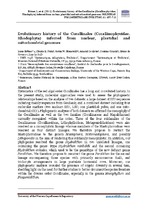| dc.contributor.author | Bittner, Lucie | |
| dc.contributor.author | Maneveldt, Gavin | |
| dc.contributor.author | Couloux, Arnaud | |
| dc.contributor.author | Cruaud, Corinne | |
| dc.contributor.author | de Reviers, Bruno | |
| dc.contributor.author | Le Gall, Line | |
| dc.date.accessioned | 2013-12-05T08:17:11Z | |
| dc.date.available | 2013-12-05T08:17:11Z | |
| dc.date.issued | 2011 | |
| dc.identifier.citation | Bittner, L., et al. (2011). Evolutionary history of the Corallinales (Corallinophycidae, Rhodophyta) inferred from nuclear, plastidial and mitochondrial genomes. Molecular Phylogenetics and Evolution, 61: 697-713 | en_US |
| dc.identifier.issn | 1055-7903 | |
| dc.identifier.uri | http://hdl.handle.net/10566/904 | |
| dc.description.abstract | Systematics of the red algal order Corallinales has a long and convoluted history. In the present study, molecular approaches were used to assess the phylogenetic relationships based on the analyses of two datasets: a large dataset of SSU sequences including mainly sequences from GenBank; and a combined dataset including four molecular markers (two nuclear: SSU, LSU; one plastidial: psbA; and one mito- chondrial: COI). Phylogenetic analyses of both datasets re-affirmed the monophyly of the Corallinales as well as the two families (Corallinaceae and Hapalidiaceae) currently recognized within the order. Three of the four subfamilies of the Corallinaceae (Corallinoideae, Lithophylloideae, Metagoniolithoideae) were also resolved as a monophyletic lineage whereas members of the Mastophoroideae were resolved as four distinct lineages. We therefore propose to restrict the Mastophoroideae to the genera Mastophora, Metamastophora, and possibly Lithoporella in the aim of rendering this subfamily monophyletic. In addition, our phylogenies resolved the genus Hydrolithon in two unrelated lineages, one containing the gener- itype Hydrolithon reinboldii and the second containing Hydrolithon onkodes, which used to be the generitype of the now defunct genus Porolithon. We therefore propose to resurrect the genus Porolithon for the second lineage encompassing those species with primarily monomerous thalli, and trichocyte arrangements in large pustulate horizontal rows. Moreover, our phylogenetic analyses revealed the presence of cryptic diversity in several taxa, shedding light on the need for further studies to better circumscribe species frontiers within the diverse order Corallinales, especially in the genera Mesophyllum and Neogoniolithon. | en_US |
| dc.language.iso | en | en_US |
| dc.publisher | Elsevier | en_US |
| dc.rights | This is the author postprint version of an article by Elsevier. The file may be freely used, provided that acknowledgement of the source is given. | |
| dc.source.uri | http://dx.doi.org/10.1016/j.ympev.2011.07.019 | |
| dc.subject | COI | en_US |
| dc.subject | Corallinales | en_US |
| dc.subject | Mastophoroideae | en_US |
| dc.subject | LSU rDNA | en_US |
| dc.subject | Phylogeny | en_US |
| dc.subject | Porolithon | en_US |
| dc.subject | psbA | en_US |
| dc.subject | SSU | en_US |
| dc.subject | rDNA | en_US |
| dc.title | Evolutionary history of the Corallinales (Corallinophycidae, Rhodophyta) inferred from nuclear, plastidial and mitochondrial genomes | en_US |
| dc.type | Article | en_US |
| dc.privacy.showsubmitter | false | |
| dc.status.ispeerreviewed | true | |
| dc.description.accreditation | Web of Science | en_US |

